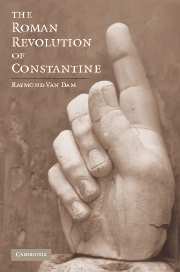Book contents
- Frontmatter
- Contents
- PREFACE
- ABBREVIATIONS
- Map
- Introduction: AUGUSTUS AND CONSTANTINE
- SECTION I A ROMAN EMPIRE WITHOUT ROME
- SECTION II A GREEK ROMAN EMPIRE
- SECTION III EMPEROR AND GOD
- Epilogue: ONE EMPEROR
- APPENDIX 1 HISPELLUM: DATE, TEXT, AND TRANSLATION
- APPENDIX 2 ORCISTUS: DATES, TEXT, AND TRANSLATION
- EDITIONS AND TRANSLATIONS
- BIBLIOGRAPHY
- INDEX
APPENDIX 1 - HISPELLUM: DATE, TEXT, AND TRANSLATION
Published online by Cambridge University Press: 05 June 2012
- Frontmatter
- Contents
- PREFACE
- ABBREVIATIONS
- Map
- Introduction: AUGUSTUS AND CONSTANTINE
- SECTION I A ROMAN EMPIRE WITHOUT ROME
- SECTION II A GREEK ROMAN EMPIRE
- SECTION III EMPEROR AND GOD
- Epilogue: ONE EMPEROR
- APPENDIX 1 HISPELLUM: DATE, TEXT, AND TRANSLATION
- APPENDIX 2 ORCISTUS: DATES, TEXT, AND TRANSLATION
- EDITIONS AND TRANSLATIONS
- BIBLIOGRAPHY
- INDEX
Summary
The best texts of constantine's rescript to hispellum are in ILS 1:158–59, no. 705, and Gascou (1967) 610–12, both derived from the edition of E. Bormann in CIL 11.2.1:768, no. 5265. Gascou's text is printed and translated here. Also included here is a summary of Gascou's important comments about the numerous oddities in grammar and spelling. For photographs, see Andreotti (1964), facing p. 288, and Lenski (2006a), Figure 4, with the comprehensive survey of earlier scholarship in Amann (2002).
Constantine himself had insisted that edicts and constitutions that did not include an exact date were invalid: see CTh 1.1.1, issued in 322. Even though his original rescript to Hispellum had undoubtedly included a date, the inscribed copy erected in the town did not. The dating of the rescript hence depends upon interpretation of the college of emperors in its heading. The heading described Constantine as Augustus, mentioned his three sons, Constantine, Constantius, and Constans, but gave them no titles. Constans joined his two older brothers as a Caesar after his investiture on December 25, 333: for the date, see Consularia Constantinopolitana s.a. 333. The younger Dalmatius, Constantine's nephew, joined his three cousins as a Caesar after his investiture on September 18, 335: for the date, see Consularia Constantinopolitana s.a. 335. Grünewald (1990) 150–53, hence dates the rescript between these two dates.
- Type
- Chapter
- Information
- The Roman Revolution of Constantine , pp. 363 - 367Publisher: Cambridge University PressPrint publication year: 2007

